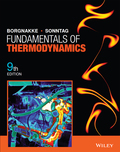
Concept explainers
A temperature difference drives a heat transfer Does a similar concept apply to
The similar concept for mass transfer like the heat transfer derived by the temperature difference.
Answer to Problem 4.1P
Mass transfer is derived by pressure difference.
Explanation of Solution
The temperature difference between two regions can lead to transfer of heat from high temperature region to lower temperature region to maintain the equilibrium of temperature between two regions.
The similar concept can be applied to the mass transfer, for instance if we consider a pipe having water flow inside it, the flow of water starts from high pressure region and flow to the lower pressure region.
The flow inside the pipe is due to the pressure difference. As water is incompressible fluid thus its density will remain same throughout the flow. Hence, the mass transfer is derived by Pressure difference.
Conclusion:
Thus, mass transfer is derived by pressure difference.
Want to see more full solutions like this?
Chapter 4 Solutions
EBK FUNDAMENTALS OF THERMODYNAMICS, ENH
Additional Engineering Textbook Solutions
Introduction to Heat Transfer
INTERNATIONAL EDITION---Engineering Mechanics: Statics, 14th edition (SI unit)
Heating Ventilating and Air Conditioning: Analysis and Design
Automotive Technology: Principles, Diagnosis, And Service (6th Edition) (halderman Automotive Series)
Degarmo's Materials And Processes In Manufacturing
Fox and McDonald's Introduction to Fluid Mechanics
- (34) Please help me answer this problem. Thank you very mucharrow_forwardA sample of water that is initially at 84.00C absorbs 500 kcal of heat. As a result, the liquid water becomes water vapor at 1150C. What is the mass of the water? (Some useful information: cwater = 1 cal/g0C, Lv,water = 540 cal/g, and csteam = 0.480 cal/g0 C. a. 488 g b. 788 g c. 588 g d. 888 g e. 688 garrow_forward4) Figure shows a gas contained in a vertical piston-cylinder assembly. The total mass of the piston (including shaft) is 100 kg. While the gas is slowly heated, the internal energy of the gas increases by 0.1 kJ, the potential energy of the piston-shaft combination increases by 0.2 kJ. The piston and cylinder are poor conductors, and friction between them is negligible. The local atmospheric pressure is 1 bar and approximate g as 10 m/s². The cross-sectional area of the piston is 0.01 m². Determine, (a) the work done by the gas, (b) the heat transfer to the gas, all in kJ. Patm = 1 bar Gas 0.01 m²arrow_forward
- Consider the following : 1. When a gas is heated at constant pressure, its temperature and volume both will increase 2. Volume V,-Vz 3. Change in heat transfer is equals to change in internal energy 4. The value of the work done is not zero Which of the above condition relates with isobaric process? Select one: O a. 1,2 and 4 only O b. 1, 2, 3 and 4 O C. 1,3 and 4 only O d. 1 and 4 only d anssad aarrow_forward1-find the internal energy in KJ of 2 kg water contained in 1120 liter at P-1 bar & v= 0.56 m^3/kg.arrow_forward1) In a piston cylinder 0.5kg of air expand polytropically from 4 bar and 1100 oC to 1 bar, the index of expansion is 1.75, find the work done and the heat transfer. Example 2.13 A steam turbine operating under steady flow conditions receives 3600 kg of steam per hour. The steam enters the turbine at a velocity of 80 m/s, an elevation of 10 m and specific enthalpy of 3276 kJ/kg. It leaves the turbine at a velocity of 150 m/sec, an elevation of 3 m and a specific enthalpy of 2465 kJ/kg. Heat losses from the turbine to the surrounding amount to 36 MJ/hr. Estimate the power output of turbine.arrow_forward
- Please show steps (explanation + formulas and calculs) for more understanding. Thank youarrow_forwardIn a piston-cylinder assembly, there is initially a pressure of 300 kPa, a temperature of 150oC and a volume of 0.5 m3 of air. Until air doubles in volume with PVn=constant polytropic processexpands as much. For n =1, n = k and n = 1.6a. final pressure of the air,b. Moving border work,c. Calculate the heat transfer.(Note: take constant specific heat values at room temperature (at 300 K).)arrow_forwardSteady and Transient state of heat transfer by the help of an example.arrow_forward
- Need correctly...arrow_forwardThere exists reduction of 1 pound of steam per minute undergoing an isothermal process from 27.5 bar, 316 deg C to 6.8 bar. Compute for steady flow work in BTU/min if change in kinetic energy is 42 hparrow_forward) Two boilers, one with superheater(B1) and other without superheater(B2) are delivering equal quantities of steam into a common main. The pressure in the boiler and main is 20 bars. The temperature of the steam from a boiler with a superheater is 350oC and temperature of the steam in the main is 250oC. The steam in B2 is wet steam at 20oC. i) Draw a sketch of the problem with all thermodynamic properties from steam table shown on the sketch. ii) Determine the quantity of steam supplied by the other boiler. Take the heat capacity of steam, Cps = 2.25KJ/Kg.hgas= hg + Cps (Tsap-Tsat)arrow_forward
 Elements Of ElectromagneticsMechanical EngineeringISBN:9780190698614Author:Sadiku, Matthew N. O.Publisher:Oxford University Press
Elements Of ElectromagneticsMechanical EngineeringISBN:9780190698614Author:Sadiku, Matthew N. O.Publisher:Oxford University Press Mechanics of Materials (10th Edition)Mechanical EngineeringISBN:9780134319650Author:Russell C. HibbelerPublisher:PEARSON
Mechanics of Materials (10th Edition)Mechanical EngineeringISBN:9780134319650Author:Russell C. HibbelerPublisher:PEARSON Thermodynamics: An Engineering ApproachMechanical EngineeringISBN:9781259822674Author:Yunus A. Cengel Dr., Michael A. BolesPublisher:McGraw-Hill Education
Thermodynamics: An Engineering ApproachMechanical EngineeringISBN:9781259822674Author:Yunus A. Cengel Dr., Michael A. BolesPublisher:McGraw-Hill Education Control Systems EngineeringMechanical EngineeringISBN:9781118170519Author:Norman S. NisePublisher:WILEY
Control Systems EngineeringMechanical EngineeringISBN:9781118170519Author:Norman S. NisePublisher:WILEY Mechanics of Materials (MindTap Course List)Mechanical EngineeringISBN:9781337093347Author:Barry J. Goodno, James M. GerePublisher:Cengage Learning
Mechanics of Materials (MindTap Course List)Mechanical EngineeringISBN:9781337093347Author:Barry J. Goodno, James M. GerePublisher:Cengage Learning Engineering Mechanics: StaticsMechanical EngineeringISBN:9781118807330Author:James L. Meriam, L. G. Kraige, J. N. BoltonPublisher:WILEY
Engineering Mechanics: StaticsMechanical EngineeringISBN:9781118807330Author:James L. Meriam, L. G. Kraige, J. N. BoltonPublisher:WILEY





